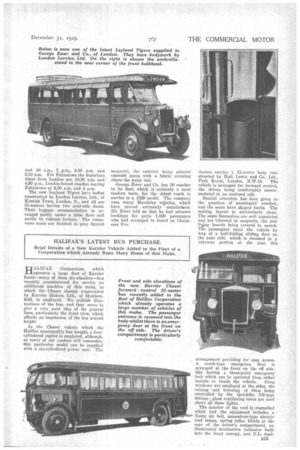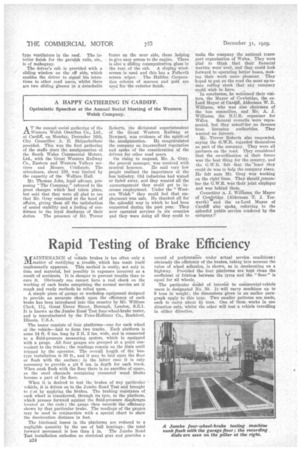HALIFAX'S LATEST BUS PURCHASE.
Page 57

Page 58

If you've noticed an error in this article please click here to report it so we can fix it.
Brief Details of a New Karrier Vehicle Added to the Fleet of a Corporation which Already Runs Many Buses of this Make.
JJALIFAX Corporation, which operates a large fleet of Karrier buses—many of them six-wheelers—has recently commissioned for service an additional machine of this make, in which the Chaser chassis constructed by Karrier Motors, Ltd., of Huddersfield, is employed. We publish illustrations of the bus, and they serve to ' give a very good idea of its general lines, particularly the front view, which affords an impression of the low overall height.
In the Chaser vehicle which the Halifax municipality has bought, a fourcylindered engine is employed, although, as many of our readers will remember, this particular model can be supplied with a six-cylindered power unit. The chassis carries a 32-seater body constructed by Hall, Lewis and Co., Ltd., Park Royal, London, N.W.10. The vehicle is arranged for forward control, the driven being comfortably accommodated in an enclosed cab.
Special attention has been given to • the question of passengers' comfort, and the seats have shaped backs. The seating layout is particularly clean. The seats themselves are well appointed and are trimmed in moquette, the side liijng boards being covered to match. Tile passengers enter the vehicle by way of a half-folding sliding door on the near side, which is recessed in a cutaway portion at the rear, this
arrangement providing for easy access. A coach-type emergency door is arranged at the front on the off side, this having a three-point emergency lock which can be operated from either
outside or inside the vehicle. Drop windows are employed at the sides, the raising and lowering of them being controlled' by the Quicktho NS-type fittings; glass ventilating eaves are used above all these lights.
The interior of the roof is enamelled white and the equipment includes a Numa air bell, moonstone-type electric roof lamps, spring roller blinds at the rear of the driver's compartment, an illuminated destination indicator built into the front canopy, and N.L. dual. type ventilators in the roof. The interior finish for the garnish rails, etc., is of mahogany.
The driver's cab is provided with a sliding window on the off side, which enables the driver to signal his intentions to other road users, whilst there are two sliding glasses in a detachable frame on the near side, these helping to give easy access to the engine. There is also a sliding comm;unication glass in the rear of the cab. A sloping windscreen is used and this has a Folberth screen wiper. The Halifax Corporation colours of maroon and gold are used for the exterior finish.




































































































